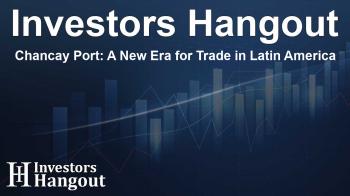Chancay Port: A New Era for Trade in Latin America

Chancay Port: A Revolutionary Trade Gateway
The expansion of trade between Asia and Latin America is entering a transformative phase with the inauguration of the Chancay Port, a flagship project aimed at enhancing connectivity and efficiency. This monumental endeavor, part of the broader Belt and Road Initiative (BRI), is poised to alter the landscape of trade in the region, with significant implications for economic growth.
Overview of the Chancay Port Project
Chancay Port represents a substantial $1.3 billion investment that aims to facilitate commerce by accommodating some of the world's largest cargo vessels. Its operational commencement marks a pivotal moment for regional logistics, as the port is designed to reduce shipping times dramatically. For instance, it will cut the transit time from Peru to China to just 23 days, thereby slashing logistics costs by at least 20%.
Infrastructure and Capacity
The port is equipped with four berths and boasts a depth of 17.8 meters, which allows it to service ultra-large container ships capable of handling 18,000 twenty-foot equivalent units (TEUs). With an intended annual throughput capacity of one million TEUs short-term and 1.5 million TEUs long-term, Chancay is set to serve as a central hub for Asian-Latin American trade.
Economic Impact and Job Creation
With significant endorsements from global leaders, the project is expected to yield around $4.5 billion in annual revenues for Peru. Furthermore, it is anticipated to create over 8,000 direct jobs, providing a considerable boost to the local economy.
Strategic Importance for Peru
Peru's Transport Minister has highlighted the goal of establishing the nation as a Latin American version of Singapore, positioning Chancay Port as a vital starting point for goods heading to Asia from across the continent. This ambition underlines the port's role as a critical nexus for regional exports, including cranberries, avocados, and more.
Enhancing Trade Routes
The strategic location of Chancay Port serves as Peru's gateway to the Pacific, ensuring seamless connectivity via a tunnel that links to the Pan-American Highway. This infrastructure paves the way for enhanced transport of various exports and is anticipated to significantly bolster trade between China and Latin America.
Development of Regional Infrastructure
Plans are underway for the development of associated rail and highway networks that will connect Chancay Port to major cities throughout Peru, with future ambitions to link it to transport networks in neighboring countries. This will aid in the efficient export of Brazilian soybeans, Colombian coffee, and other key goods.
Connecting Latin America with Asia
As described by President Xi, the Chancay Port project is more than a mere infrastructure development; it symbolizes the growing ties between China and Latin America. It integrates the region into the dynamic economic framework of the Asia-Pacific, fostering greater connectivity and cooperation.
The Future of China-Latin America Relations
Since the BRI's inception, 22 Latin American nations have formalized cooperation agreements with China, reflecting a commitment to strengthening economic partnerships. China's status as the second-largest trading partner for the region, with overall trade volume exceeding $489 billion in 2023, highlights the significance of these ties.
Continued Support for Economic Development
Experts emphasize that China's investment is not solely about financial gain; it is also crucial for the technological and industrial growth of Latin American countries. By attending key regional summits, leaders like Xi can further invigorate prospects for regional integration and cooperation.
Conclusion
The Chancay Port project represents a groundbreaking advancement in Latin America's trading capabilities. It not only enhances shipping efficiency but also fosters a spirit of collaboration between nations, ultimately laying the groundwork for a prosperous economic future that benefits numerous countries across the continent.
Frequently Asked Questions
What is Chancay Port?
Chancay Port is a $1.3 billion project aimed at improving trade routes between Peru and Asia, facilitating faster shipping and reducing costs.
How will Chancay Port benefit Peru?
The port is expected to generate $4.5 billion annually and create over 8,000 jobs, significantly boosting the local economy.
What types of goods will be exported through Chancay Port?
Exports will include products like cranberries, avocados, Brazilian soybeans, and Colombian coffee, aimed at Asian markets.
Why is Chancay Port strategically important?
The port connects trade routes, reduces shipping times, and positions Peru as a logistics hub in Latin America.
How does the BRI impact Chancay Port?
The Belt and Road Initiative facilitates investment and development of projects like Chancay Port, enhancing economic ties between China and Latin America.
About Investors Hangout
Investors Hangout is a leading online stock forum for financial discussion and learning, offering a wide range of free tools and resources. It draws in traders of all levels, who exchange market knowledge, investigate trading tactics, and keep an eye on industry developments in real time. Featuring financial articles, stock message boards, quotes, charts, company profiles, and live news updates. Through cooperative learning and a wealth of informational resources, it helps users from novices creating their first portfolios to experts honing their techniques. Join Investors Hangout today: https://investorshangout.com/
Disclaimer: The content of this article is solely for general informational purposes only; it does not represent legal, financial, or investment advice. Investors Hangout does not offer financial advice; the author is not a licensed financial advisor. Consult a qualified advisor before making any financial or investment decisions based on this article. The author's interpretation of publicly available data shapes the opinions presented here; as a result, they should not be taken as advice to purchase, sell, or hold any securities mentioned or any other investments. The author does not guarantee the accuracy, completeness, or timeliness of any material, providing it "as is." Information and market conditions may change; past performance is not indicative of future outcomes. If any of the material offered here is inaccurate, please contact us for corrections.
